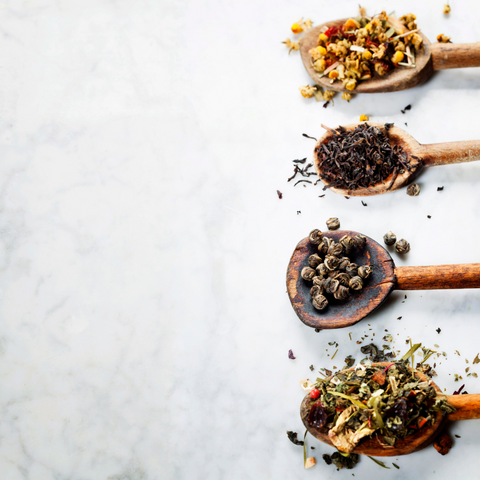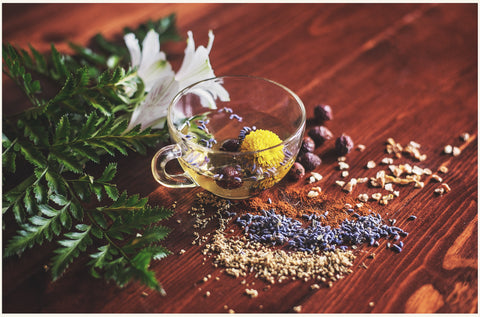Whether you’re shopping for tea at a specialty shop or your neighborhood grocery store, you’re bound to find an extensive variety of options. For nearly 5,000 years, humans have enjoyed this beverage, and it has evolved to be understood as a broad category of drinks made from leaves, flowers, herbs, and fruits steeped in water.
From true teas to herbal blends, there’s a tea that pairs perfectly with any occasion. However, without the necessary background on how tea is grown, deciding which tea to choose may feel overwhelming. Luckily, it only takes a basic understanding of tea to figure out where to begin.
We’re here to share with you the story of tea, from harvest to cup.

Farm to Table
Tea first originated in ancient China and has since made its way around the world to become a staple in many cultural traditions. Today, we can find a seemingly endless variety of beverages labeled as tea, include herbal blends and exotic flora. True tea,however, all comes from the same plant: Camellia sinensis.
Planting the Seed
The story of tea begins with a seed planted on a farm. Even in these early days, the end profile can be affected by the terroir, the growing environment of the tea. From soil quality, to elevation, to temperature and moisture, the conditions in which the plants grow can have a major impact on the resulting flavor of each bach.
Understanding how each of these factors affects the tea allows farmers to control the terroir according to the desired outcome. Japanese green tea such as the Gyokuro variety, for example, is commonly shaded prior to harvest, causing the plants to produce higher amounts of chlorophyll and theanine.
Harvest
Once the tea plant is grown, it must then be harvested, and the method in which this is done can also affect the end product. Premium leaves are still hand-plucked to preserve their original state, whereas many mass-produced teas are harvested with machines.
While machines make the operation much quicker, they also cut and bruise the leaves in the process. These broken leaves speed up the brew time of the resulting tea and bring forth a bolder flavor. Because a strong cup is not desirable for all teas, both methods of harvesting remain prominent to this day.
Once the leaves are harvested, they undergo a series of stages in which they are prepared according to the type of tea they will become.

From Raw Leaf to a Fresh Brewed Cup
Processing raw leaves into drinkable tea requires a five-stage process. While many teas are now mass-produced with the use of machines, it is still common to find people using traditional hand processing, as well as a combination of the two methods.
All teas, more or less, follow the same stages of processing, but alterations in each stage are what lead to the distinct variety of teas they become.
Withering
The first stage of the process is withering the leaves. This reduces the water content of the leaves by over 50%, making them pliable and ready for further processing.
This stage is lengthy and controlled with precision. Leaves are air-dried on wire racks for a time period of anywhere from 12 to 17 hours. The humidity and temperature of the environment are also strictly controlled throughout process. If too much heat and moisture are present, tea leaves will cook much like vegetables, so it is important for farmers to monitor the environment to ensure that the leaves dry out slowly instead.
Rolling
Once the leaves are withered and subtle, they proceed to the next stage in which they are rolled. The twisting and pulling that happens from rolling breaks the leaves and opens them up to allow them to release more of their goodness. While this process is traditionally done by hand, it can be extremely time consuming and is commonly done with rolling machines today.
The amount that the leaves are torn affects how bold of a flavor and aroma the resulting tea will have. This can especially be seen when another method of tearing the leaves, known as the Cut, Tear, Curl method (also CTC or Crush, Tear, Curl method) is used to tear the leaves instead.
The CTC method was invented during WWII as a way of speeding up the process. Instead of simply rolling the leaves, they are instead sent through rollers with sharp teeth that shred the leaves up. Shredded leaves mean smaller pieces and more tears, producing a bolder tea in a shorter brewing time.
Although the method was invented for efficiency, the outcome has helped it stick around. Today, the CTC method is still commonly used, particularly when processing black tea. To understand why black tea is the ideal choice for this process, we can take a look at the next stage.
Oxidation
The third stage that tea leaves undergo is the process of oxidation. This stage is really where the magic happens, because the degree to which the leaves are oxidized determines what type of tea they will become. Oxidation determines not only the color of the tea, but also the taste, strength, and aroma of the end product.
The longer tea leaves are oxidized, the bolder a tea they will produce. The bruised and torn parts of the leaves will begin to brown during this process, much as apples and avocado do after they’ve been cut open. If the leaves oxidize long enough, the entire leaf will eventually turn brown. The darker the leaves, the darker and more flavorful the tea.
Fixing
Once the leaves have reached the desired level of oxidation, they have to be ‘fixed’ to stop the process. This is done by heating the leaves, which denatures the enzymes that react with oxygen. Although you may hear this stage referred to as Kill Green, it actually preserves the remaining amount of green left in the leaves. Only black tea bypasses this step altogether because it is already oxidized until there is no green left to preserve.
Drying
The fifth and final stage of processing tea is drying it out to remove most of the remaining water content down to around 3%. Removing any remaining water makes tea shelf stable. The tea is then ready to be packaged and distributed to the masses.

True Teas
Despite beginning as the same tree, true tea comes in many varieties, including:
• Green
• Black
• White
• Oolong
The difference in these teas comes from the way they are prepared and lies in the fine details. Although they go through the same stages of processing, slight alterations lead to significant differences in taste, color, aroma, and overall experience of each tea.
Green Tea
Green tea is unique in that it undergoes no oxidation. The oxidation stage is completely skipped in order to preserve the light and fresh color and flavor of the tea leaves. Instead of oxidizing, green tea leaves are commonly either pan dried or steamed to release any enzymes that could react with the air. There are also several rolling methods unique to green tea. Gunpowder tea, for example, is twisted into cone shapes that resemble bullets. Other methods of rolling green tea include curved arches and wound spirals.
Black Tea
Black tea is green tea’s counterpart. It is fully oxidized and derives its name from the dark shade the leaves and resulting tea take on from the oxidation process. It is also common for black tea to be more bruised and cut than other teas because these lesions allow the water to extract more from the leaves in a shorter amount of time.
Oolong Tea
Oolong tea is a partially oxidized variety that offers the best of both worlds. After wilting, the edges of leaves are bruised by shaking them in baskets or rolling them in cloth. Only bruising parts of the leaves means only those parts oxidize. They are then oxidized until the leaves are approximately 30% browned and 70% green.
White Tea
White tea is made from only the unopened buds and young leaves of the tea plant. Before blooming, these buds still contain small, white hairs, which is where the tea gets its name. In processing, white tea skips the oxidation and rolling stages, but is simply withered and then allowed to dry. As white tea is the least processed of all teas, it is usually dried under a low heat, or sometimes even directly by the Sun.
A Whole World of Variations
Now that you understand the differences in true tea, you are prepared to walk down the tea aisle and differentiate between the many boxes presented to you. And if this tale of tea has brewed-up some interest in this ancient beverage, you may be ready to broaden your scope to explore the many other types of tea available.
From fermented teas like Kombucha and Pu-her, to floral and herbal varieties such as Hibiscus, Rooibos, and Chamomile, our defined category of tea spans far and wide. Each variety offers unique smells, flavors, and health benefits, and each blend only expands the possibilities. Whether you’re feeling under the weather or are having afternoon tea with a friend, the story of tea can serve as a guide to exploring its many delectable and nutritious varieties.



